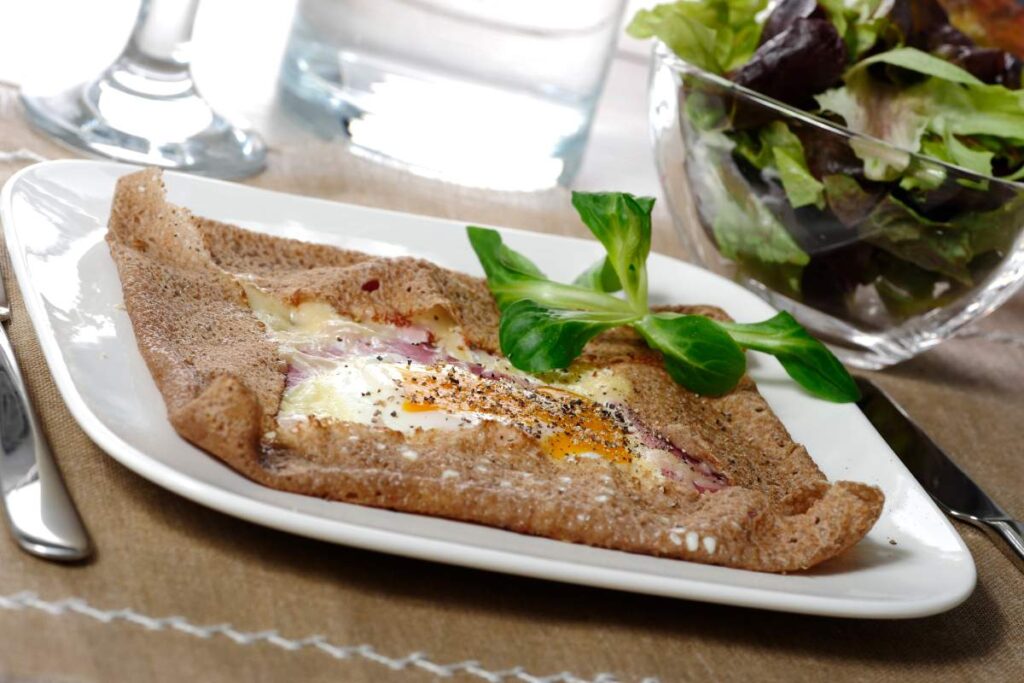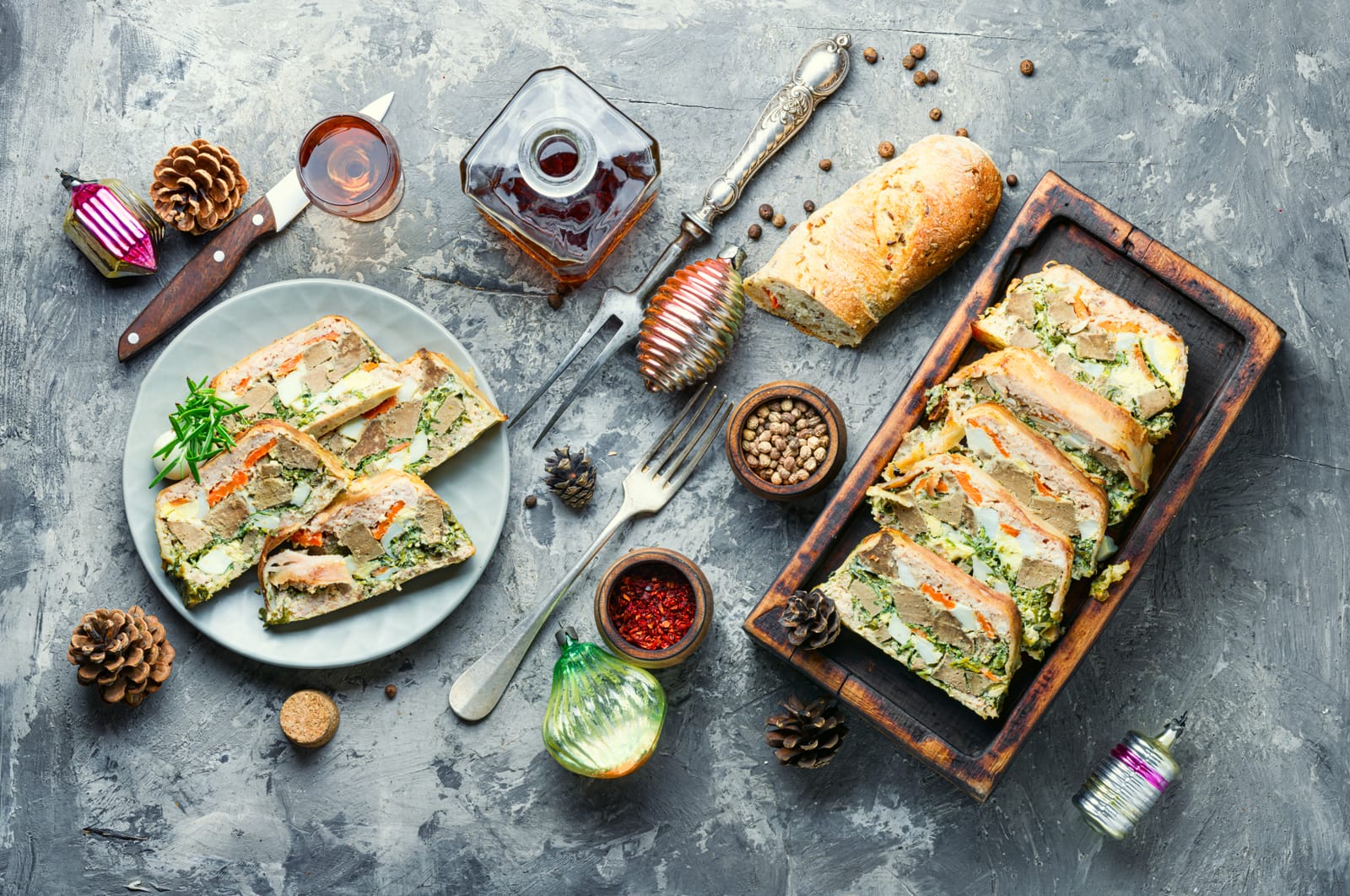What food is France known for? French cuisine offers an unrivaled mix of technique, regional identity, and cultural pride, from buttery croissants and wine-braised stews to colorful macarons and rustic vegetable dishes. This diversity is especially evident when Renting a Castle in France, where regional cuisine meets local terroir and culinary heritage in an unforgettable setting.
Whether you’re planning your first trip to France or deepening your appreciation from home, this curated list goes beyond clichés.
We unpack where each dish comes from, what makes it special, and how to enjoy it authentically, so you know exactly what food France is known for and why it continues to inspire food lovers worldwide.
Why French Cuisine Captivates the World
French cooking is more than a collection of recipes; it is a living heritage recognized by UNESCO for its cultural significance. In 2010, the “gastronomic meal of the French” was inscribed on UNESCO’s Intangible Cultural Heritage list, highlighting not only the dishes themselves but the convivial spirit, time-honored etiquette, and ritualized structure that make dining in France a communal celebration.
From the opulent banquets of Versailles—where gilded halls once echoed with toasts and the clatter of silverware—to the humble village bistros serving rustic stews over gingham tablecloths, every meal embodies a seamless fusion of technique, terroir, and tradition.
The Power of Terroir
At the heart of French cuisine lies the concept of terroir—the distinctive imprint imparted by a region’s soil, climate, and local practices. This notion ensures that even the smallest village can stake its claim on the gastronomic map.
In Burgundy, chalky limestone soils nurture Chardonnay grapes that yield crisp, mineral-driven whites. In the Southwest, limestone plateaus around Périgord nurture oak trees whose moths become the fabled black truffle.
Each locale offers a specialty—a creamy Reblochon from Savoie, peppery Chorizo from Auvergne, or tangy Corsican chestnut flour used in farine de châtaigne pancakes—inviting travelers to embark on delicious detours off the beaten path. If you’re lucky enough to visit during one of the many French Food Festivals, you’ll witness how each region celebrates its unique culinary gifts with flair.
At Château de Lasfonds, perched between Périgord Vert and Charente, guests experience terroir firsthand. Our private chef sources vegetables from nearby market gardens, forages wild mushrooms in our woodland, and selects Cognac from a family-run distillery just 20 minutes away. The result is a menu that tells a story of land and lineage, where each ingredient arrives at the château imbued with a sense of place and history.
Mastery of Technique
While terroir highlights the raw material, classical technique transforms it into a culinary art. Auguste Escoffier, the legendary chef who modernized French cooking in the late 19th and early 20th centuries, codified methods, such as mise en place (precise preparation), sauce-making, and hierarchical kitchen brigades, that remain the backbone of professional kitchens worldwide.
These techniques elevate even the simplest preparations: a silky beurre blanc (white butter sauce) relies on painstaking emulsification of butter, vinegar, and shallots; a golden pâte à choux puffs perfectly when expertly piped and baked; and a festive bûche de Noël requires deft folding of meringue, ganache, and sponge.
Dining at Château de Lasfonds brings these techniques to life in an intimate setting. Guests are invited to witness our chef in one of two fully equipped kitchens—observing the alchemy of sous-vide precision, the art of sugar pulling for confectionery, or the delicate timing needed to bloom saffron in a bouillabaisse stock.
By seeing the technique in action, visitors gain a deeper appreciation for the skill and training it takes to make French cuisine reliable and thrilling.
The Ritual of Dining
In France, dining is an unhurried ritual. Meals progress through a deliberate sequence: hors d’œuvre to awaken the appetite, entrée or first course, plat principal at the meal’s heart, fromage to cleanse and contrast, and dessert for a sweet denouement.
Conversations are meant to linger, sidelong glances exchanged over wine glasses, and laughter rising amid the clink of fine crystal. Bread holds its status—not merely a sidecar but a utensil of respect; it participates in the meal, used to scoop sauces, catch falling morsels, and symbolize the abundance at the table.
Even tearing a fresh baguette—listening to its crust shatter and inhaling the yeasty fragrance—is an immersive prelude to the following courses.
At our château, this ritual takes on heightened meaning. A morning stroll through dew-kissed gardens leads to a breakfast of warm croissants delivered by a steward to each room. This elegant start to the day is also a favorite among couples planning a French Chateau Wedding, as shared meals form the heart of the celebration. Luncheon under the shade of ancient chestnut trees transitions seamlessly into an afternoon aperitif—perhaps a fresh rosé paired with local foie gras.
In the grand dining hall, dinner unfolds by candlelight: seven courses accompanied by thoughtfully chosen wines from our vaulted cellar. In each moment, time expands, and guests rediscover the pleasure of unhurried company and intentional savoring.
Four Pillars of French Flavors
Four key principles underpin why French cuisine continues to captivate palates around the globe:
- Quality Ingredients Transformed Through Precise Techniques
Whether it’s a flagship Burgundy wine braised into coq au vin or the finest butter layered into croissants, the starting point is always exceptional produce. Technique then refines caramelizing, deglazing, and emulsifying elements to coax out the most decadent flavors. - Wine-Braised Dishes That Create Complex Flavors
French stews such as Bœuf Bourguignon and Cassoulet harness the power of slow braising in regional wines, melding tannins, meat, and vegetables into unctuous pottages that marry depth with subtlety. - Elegant Presentations That Showcase Simple Tastes
From the minimalist plating of a dauphinoise gratin to the rustic art of a charcuterie board, French chefs understand that beauty on the plate amplifies anticipation, inviting diners to engage the senses before the first bite. - Balanced Flavor Combinations Refined Through Generations
The marriage of sweet and savory in a Tarte Tatin, the dance of garlic-parsley butter in Escargots de Bourgogne, or the interplay of herbs de Provence in a Ratatouille all speak to the generations of experimentation that define French flavor profiles.
A Global Legacy
French cuisine’s influence extends far beyond its borders. Culinary schools from New York to Tokyo adopt Escoffier’s brigade system; Michelin stars often guide diners toward French-inspired fine dining; and chefs everywhere revere the rigors of sauces, stocks, and pastries first perfected in France.
Yet, for all its global reach, authentic French cuisine remains a living, local practice—rooted in markets, terroir, and centuries-old family recipes.
Château de Lasfonds offers a portal into this vibrant legacy. Here, guests don’t merely taste French food—they inhabit its values: respect for ingredients, mastery of technique, ritualized dining, and the belief that every meal is an opportunity to connect.
In doing so, they understand why French cuisine continues to captivate the world, not just as a culinary achievement, but as a profound expression of culture.
10 Classic Dishes That Define French Cuisine
These 10 dishes go beyond stereotypes to represent the true heart of French cooking—from coastal stews to Alpine comfort food, refined pastries to rustic classics. Each one offers a window into the culture, terroir, and timeless techniques that make France the global capital of gastronomy.
1. Coq au Vin
Photo from unlimphotos: French classic, coq au vin or chicken in red wine with mushrooms, onion and bacon.
Coq au Vin is a classic French stew from Burgundy, made by braising chicken in red wine with bacon, mushrooms, onions, and herbs. Though its roots trace back to ancient Gaul, the written recipe only appeared in the 20th century.
Traditionally made with an old rooster, the dish is slow-cooked, creating tender meat and a rich, velvety sauce. The chicken is first seared, then simmered in Burgundy wine with thyme, bay leaf, and parsley. While some versions use brandy or other regional wines, the essence remains hearty and home-style. Today, it’s a staple on bistro menus across France.
2. Bœuf Bourguignon
Bœuf Bourguignon is a rich beef stew from Burgundy, slow-braised in red wine with vegetables and herbs. Though popularized in the 19th century, it has become a symbol of French comfort food.
The dish features cubed beef (like chuck or brisket), bacon, carrots, onions, garlic, and a bouquet garni, all simmered in Burgundy wine and beef stock. It’s finished with pearl onions and mushrooms, creating a deep, savory flavor.
Long, gentle cooking ensures tender meat and a velvety, wine-infused sauce—an authentic taste of Burgundy’s love for beef and wine.
3. French Onion Soup (Soupe à l’oignon)
Photo from unlimphotos: Bowls of onion soup on the wooden board
Soupe à l’oignon, or French onion soup, is a beloved classic known for its rich, caramelized flavor and gooey cheese topping. Though onion soups date back to ancient times, the gratinéed version we recognize emerged in 18th–19th century Paris.
It became a late-night staple among workers and remains a popular starter today. The dish begins with onions slowly caramelized in butter, then simmered in beef or chicken broth with a splash of white wine. Before serving, it’s topped with toasted bread and melted Gruyère or Comté, creating a savory, bubbling cheese crust over intensely flavorful broth.
4. Cassoulet
Photo on unlimphotos: French cassoulet and tomato on a plate
Cassoulet is a rich white-bean stew from southwest France, deeply rooted in Occitan tradition. Once a humble peasant meal, it’s now a revered regional specialty. The dish combines slow-cooked white beans with meats like pork belly, duck confit, and garlic sausage—layered with herbs, garlic, and tomato, then baked for hours.
A signature breadcrumb crust forms on top and is stirred back in for added depth. Though its exact origin is debated, towns like Castelnaudary and Toulouse proudly claim it. Cassoulet’s heart lies in its rustic, slow-cooked comfort and celebration of local ingredients.
5. Bouillabaisse
Photo from unlimphotos: Bowl of Bouillabaisse – french soup with seafood
Bouillabaisse is a traditional fish stew from Marseille, known for its bold flavors and rich heritage. Initially made by fishermen using leftover rockfish, it evolved into a celebrated Provençal dish.
True bouillabaisse features at least four types of Mediterranean fish, simmered with saffron, fennel, garlic, and orange zest in a fragrant broth.
It’s served in two parts: a golden, spiced soup with toasted bread and rouille (a saffron-garlic sauce), followed by the fish filleted tableside. Though complex and time-intensive, bouillabaisse remains Marseille’s culinary pride and a soulful taste of the sea.
6. Tartiflette
Photo from unlimphotos: Tartiflette – a French dish made with potatoes, reblochon cheese, lardons and onions.
Tartiflette is a rich, cheesy potato gratin from the French Alps, created in the 1980s to spotlight Reblochon cheese. Inspired by traditional Alpine fare, it layers sliced potatoes, onions, and smoky bacon, then bakes them under a melting half-wheel of Reblochon.
A splash of white wine or cream deepens the flavor. The result is golden, gooey, and deeply comforting—perfect for cold mountain nights. Variants like croziflette (with pasta) or morbiflette (with Morbier cheese) show the dish’s evolving charm.
7. Galettes

Photo from freepik. Galette complète with ham, cheese, and egg on a plate, served with fresh salad.
A beloved dish from Brittany in northwestern France, galettes are savory crêpes made from buckwheat flour, which gives them a distinctive nutty flavor. Typically filled with ingredients like ham, cheese, mushrooms, spinach, or egg, they are a popular choice for casual lunches and street food.
The most classic version—galette complète—features ham, a runny egg, and melted cheese. Often served with a glass of Breton cider, galettes are a celebration of rustic, regional French cuisine.
8. Croissants

Photo from freepik. Freshly baked croissant on cake stand on the counter in the coffee shop
Croissants are flaky, buttery pastries that have become a symbol of French breakfast culture. Inspired by the Austrian kipferl, the French perfected it through laminating—rolling and folding butter into yeasted dough to form delicate, crisp layers.
Traditionally unsweetened, croissants come in many forms: plain, almond-filled, chocolate-filled (pain au chocolat), or savory with ham and cheese. A fresh croissant from a Paris boulangerie is a morning ritual in itself.
9. Macarons
Photo from unlimphotos: Classic Macarons with Raspberry, Coffee, Chocolate and Pistachios Filled with Cream, French Pastry
Macarons are delicate, meringue-based sandwich cookies made from almond flour, egg whites, and sugar. Unlike coconut macaroons, French macarons feature two smooth, chewy shells filled with ganache, buttercream, or jam.
Perfected in 20th-century Paris—thanks to famed pâtisseries like Ladurée—they come in flavors like pistachio, rose, and salted caramel. Their crisp exterior, soft interior, and vibrant colors make them a beloved French treat and a hallmark of Parisian pastry artistry.
10. Ratatouille
Photo from unlimphotos. Sandwich with ratatouille on the plate
Ratatouille Niçoise is a classic Provençal stew made from summer vegetables like tomatoes, eggplant, zucchini, bell peppers, and onions. Originating in Nice, it began as a rustic farmer’s dish and evolved into a beloved symbol of Mediterranean cooking.
The vegetables are sautéed and gently stewed with olive oil, garlic, and herbs like thyme and basil. The result is a rich, tender medley that’s naturally vegan, gluten-free, and bursting with sun-soaked flavor.
Dining Etiquette in France
France is famously polite in restaurants. A few key rules will help you feel at ease:
Tipping
French restaurants must include a 15% service charge (“service compris”) in the bill. You are not obliged to leave an extra tip, though it’s kind to round up or drop a euro or two for exceptional service. In cafés and casual spots, simply rounding up to the nearest euro is common. Don’t feel social pressure to tip like in the U.S. – French servers earn a living wage by law.
Ordering
Always greet the staff with “Bonjour” or “Bonsoir” when you enter (the French start with politeness). Similarly, when making a reservation or ordering by phone, begin with “Bonjour” and use the 24-hour clock (19h, not 7 pm) to avoid confusion.
Menus are typically not translated; if you’re unsure about a dish, ask “Que me conseillez-vous?” (“What do you recommend?”). It’s considered rude to call out “Garçon!”—instead, make eye contact and a polite “Monsieur/Madame!” if needed.
Meal hours
The French have set dining hours. Lunch is usually served 12:30–14:30, and dinner service begins around 19:30–20:00. Restaurants may close mid-afternoon (especially away from big cities), so plan accordingly.
Evenings start later than in some countries – don’t expect a restaurant to serve dinner before 7 p.m.. Also note that many French eat leisurely: a dinner can last two hours. When you make a reservation, be punctual – the French respect their allotted dining time, and a no-show is taken seriously.
Conduct
Keep conversation at a moderate volume, and don’t rush. Use utensils for most food; sandwiches are often eaten with a knife and fork. At a multi-course meal, observe the pace – usually an appetizer is followed by a salad or cheese course. Sharing dishes (e.g., splitting a salad) is fine, but if you do, ask the server to bring extra forks. And remember to say “s’il vous plaît” and “merci” frequently – courtesy goes a long way.
For travelers seeking more than a hotel experience, these traditions come alive when you Stay in a Château in France—where dining isn’t just a meal, but a ritual woven into the rhythm of rural life.
Why Food Tastes Better in Château de Lasfonds Castle
What Food Is France Known For? Photo of Château de Lasfonds
Your adventure into French gastronomy becomes even more meaningful from the elegant comfort of Château de Lasfonds. Every meal here can become part of your French story, whether you enjoy it in the château’s refined dining room or venture to nearby restaurants showcasing the region’s finest offerings. The 19th-century estate spans 6.5 hectares of parkland, where every view naturally lifts the flavor of each bite.
At Lasfonds, you’ll also benefit from your private chef, who transforms locally sourced ingredients into bespoke culinary masterpieces—whether a relaxed al-fresco lunch or a multi-course dinner by candlelight.
Two fully equipped kitchens ensure that no request is beyond reach, and our concierge stands ready to connect you with specialised culinary partners for truffle hunts, market tours, or winemaker visits. You’ll receive detailed recommendations—addresses, opening times, and insider tips—for the best restaurants, shops, and food experiences in Périgord Vert and Charente. If you’re looking to explore further, the region is home to some of the Best Wine Regions in France—perfect for pairing your meals with unforgettable local vintages.
This French approach to dining—patient, appreciative, and communal—shows how meals are the lifeblood of cultural identity and human connection. At Château de Lasfonds, that philosophy comes alive in every dish, every setting, and every shared moment, inviting you to discover the timeless pleasures of country-estate living.
What Food Is France Known For? Frequently Asked Questions (FAQs)
France is known for classics like boeuf bourguignon, coq au vin, croissants, and macarons. These dishes highlight France’s mastery of technique, local ingredients, and cultural tradition.
While there’s no official national dish, pot-au-feu is often considered the epitome of French home cooking. This beef stew combines slow-cooked meat and vegetables, reflecting comfort and simplicity.
Crêpes, jambon-beurre sandwiches, and regional snacks like socca in Nice are popular street foods. These quick bites show how everyday French food still reflects regional flavor and technique.
Visit local bistros, regional markets, or châteaux like Château de Lasfonds. These experiences offer insight into traditional dishes, preparation methods, and locally sourced ingredients.
Dishes like ratatouille, tartiflette, and bouillabaisse reflect the concept of terroir—how place and tradition shape taste. Combined with precise cooking techniques, they define the uniqueness of French cuisine.
Sweet crêpes are made with wheat flour and filled with sugar, chocolate, or fruit. Savory galettes use buckwheat flour and are often filled with ham, cheese, and eggs. Both are iconic in French culinary culture.
Confit de Canard is a standout. Duck legs are cured with salt, slow-cooked in their own fat, then crisped before serving. It’s a rich, traditional dish that reflects Southwest French cooking.
Ratatouille is France’s signature vegetable stew, made with eggplant, zucchini, peppers, tomatoes, and herbs. It’s both hearty and healthy, capturing the Mediterranean spirit.
Guests at Château de Lasfonds enjoy curated menus featuring regional specialties, fresh market produce, and classical technique—bringing to life the very essence of what food France is known for.
Tarte Tatin, an upside-down caramelized apple tart created by accident in the 1880s, is now a cherished dessert symbolizing rustic elegance.
Soupe à l’Oignon Gratinée is a beloved French onion soup topped with melted Gruyère over toasted bread. It’s both comforting and intensely flavorful.
This Burgundy-born dish features beef slow-braised in red wine with onions, carrots, and mushrooms. Its depth of flavor and tender texture make it a French culinary staple.




